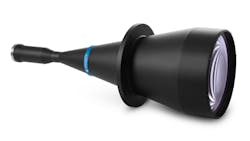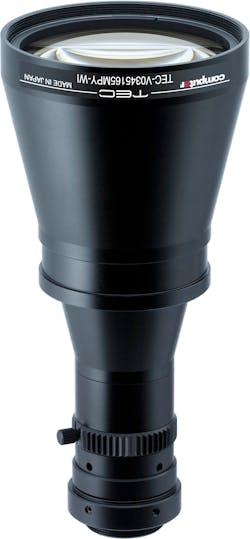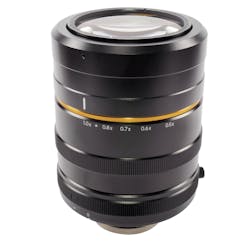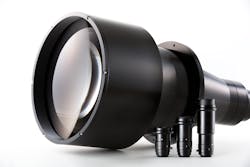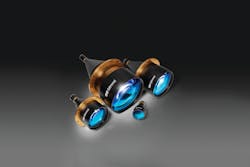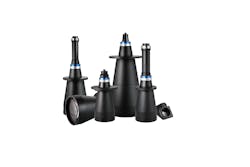Telecentric lens companies keep pace with image sensor evolution
By always offering a constant, non-angular field of view, telecentric lenses provide machine vision applications requiring precise, repeatable measurements or inspections the highest possible accuracy of all lens types. Telecentric lens manufacturers continue to advance the technology by releasing new lenses tailored to the latest large format image sensors. The following article looks at some recent developments in the field.
To address the increasing demands for high-resolution applications, for example, Opto Engineering (Mantova, Italy; www.opto-e.com) recently released new telecentric lenses designed for 12 MPixel image sensors and up, according to the company. This includes the TC3MHR-5MHR CORE PLUS series of large field of view lenses, which target 1.1 in. image sensors like Sony’s (Tokyo, Japan; www.sony.com) 12.3 MPixel IMX304 or 4/3 in. sensors like ON Semiconductor’s (Phoenix, AZ, USA; www.onsemi.com) KAC-12040. Designed to measure large objects in a reduced space, these lenses offer fields of view of around 144 to 260 mm, magnification from 0.053X to 0.117X, and come in C or F-Mount options.
Suitable for image sensors with up to a 33.5 mm image circle, the company’s TC12M lenses (Figure 1) fit large sensors, up to APS-H format. The F-Mount lenses working distances from 42.3 to 542.8 mm and magnification from 0.115X to 1.825X. From the company’s 360° OPTICS series, the TCCAGE bi-telecentric C-Mount lenses allow for a 360° telecentric view on parts with sensor sizes up to 1.1 in. and 4/3 in. and can inspect parts as tall as 8 and 16 mm. Additionally, TC Core Plus (TCCP) series C-Mount lenses suit the latest 1/1.8 in. and 2/3 in. CMOS image sensors and offer working distances of 217.4 mm to 366 mm and magnification options of 0.027 to 0.059X.
Also designed for image sensors of up to 12 MPixels, the TEC-V0345165MPY-WI series (Figure 2) from Computar (Cary, NC, USA; www.computar.com) specifically target Sony’s 12 MPixel IMX253 CMOS image sensor with 3.45 μm pixel size. These C-Mount lenses are designed for a 165.2 mm working distance and offer 0.345X magnification.
Able to resolve up to 21 MPixels, the 4/3 in. LM1119TC C-Mount lens (Figure 3) from Kowa American Corp. (Torrance, CA, USA; www.kowa-usa.com) offers telecentricity from 0.5 to 1X magnification and working distances of 80 mm (0.5X) and 81.8 mm (1X).
“Kowa’s LM1119TC is unique in that it is a large format 4/3” telecentric lens designed with a variable magnification, so unlike telecentric lenses that require switching out the rear optical parts, one can rotate the barrel to change the magnification range from 0.5X to 1X,” says Andrew Kam, National Sales Manager, Kowa. “At 120lp/mm resolution, the LM1119TC suits applications that need to quickly perform repeatable, high accuracy measurements such as surface and image defect inspections.”
VS Technology (Tokyo, Japan; https://vst.co.jp/en) makes several telecentric lens series, including the VS-TLS (Figure 4), which support up to 12 MPixel, 1.1 in. sensors. Available in six models, these lenses offer working distances of 300 to 500 mm and can be reconfigured with different rear units to change magnifications, ranging from 0.029X to 0.1X. Optimized for 1.1 in. sensors with 3.45 μm pixels, VS-THV lenses offer 0.5X, 0.8X, 1X, 1.5X, 2X, and 3X magnification options, and optional built-in coaxial illumination. These C-Mount lenses have working distances of 80 mm up to 152 mm.
In the VS-TEV series, the lenses support 1.1 in. sensors with 3.45 μm pixels and offer three variable magnification ranges of 0.3X to 0.5X, 0.5X to 0.75X, and 0.75X to 1X. The C-Mount lenses feature working distances of 125.8 to 221.5 mm, 133.9 to 173.2 mm, and 114 to 133.9 mm. The VS-TCM series of large format lenses support larger 1.1 in. sensor formats and offer 0.3X to 7X magnification. These C-Mount lenses have working distances ranging from 50.4 to 150.8 mm.
Related: Line scan camera technologies evolve to meet growing market needs
Additionally, the company introduced telecentric lenses for SWIR imaging in September with the release of the VS-THV-SWIR series, which support image sensors of 1.1 in. and 1 in., with optical magnification of 1X, 1.5X, 2X, 3X, and 4X. These lenses suit the 1000 to 1600 nm range and have working distances of 110.4 mm,111.1 mm, and 111.2 mm.
“VS Technology’s telecentric lenses come available in a wide range of optical magnification and working distances to meet the needs of various machine vision applications,” says Yuji Sugahara, Director of Marketing, VS Technology. “This includes several image sensor sizes, distortionless designs, large sensors, and high-resolution cameras. Additionally, we offer custom production and OEM supply.”
For its part, Edmund Optics (Barrington, NJ, USA; www.edmundoptics.com) offers two series of telecentric lenses for larger format image sensors, including the TECHSPEC TitanTL series (Figure 5), which support sensor formats of 1/1.8 in., 2/3 in., 1 in., 4/3 in., and 35 mm. Available in C-Mount, M42 x 1.0, F-Mount, and M58 x 0.75 options, the lenses support working distances of 110 to 379 mm and have magnification options ranging from 0.037X to 0.337X.
Meanwhile, the company’s TECHSPEC PlatinumTL telecentric lenses support sensor formats of 2/3 in., 1 in., 1.1 in., and APS-C and offer C-Mount, F-Mount, and M42 x 1.0 options. Additionally, the lenses have working distances ranging from 111 to 182 mm and magnification options of 0.28 to 1.7X.
“Compatible with the Kodak [ON Semiconductor] 4 MPixel 1.3 in. sensor and other larger format sensors such as 7 µm pixel, 4k line scan cameras, the TECHSPEC PlatinumTL lenses produce unparalleled levels of contrast of 72 lp/mm across the full sensor field. This results in maximum image quality with the highest degree of measurement accuracy,” says Cory Boone, Lead Technical Marketing Engineer, Edmund Optics.
Sill Optics (Wendelstein, Germany; www.silloptics.de/en) makes several telecentric lenses (Figure 6) for larger format image sensors, including 52, 56, 70, and 82 mm image sensor sizes. Offered in M72 x 0.75 and M90 X 1 formats, these large sensor format lenses have working distances of 114, 142, and 180 mm and magnification options of 0.65X to 1.5X. The company also offers lenses specifically for 12 to 24 MPixel image sensors such as Sony’s IMX387 or 530 CMOS image sensors. Offered in C-Mount, M35 x 0.75, and M42 X 1, the lenses have working distances of 180, 284, and 300 mm and magnification options of 0.13X to 0.3X.
The S5LPJ1750 and S5LPJ6150 C-Mount lenses cover typical 1.1 in., 3.45 µm image sensors like the Sony IMX304 and IMX253 and feature working distances of 284 mm and 180 mm, and magnification options of 0.166X and 0.244X, respectively.
OPT Machine Vision (Guangdong, China; https://en.optmv.com/) develops several telecentric lens options, including the OPT-CZT0510X – a C-Mount lens with 0.5X to 1X magnification that suits up to 1/1.2 in. image sensors and has a working distance of 108 mm. Made to work with 1.1 in. image sensors, the KS series of C-Mount lenses offer working distances of 110 to 220 mm. Lastly, the TS series of bi-telecentric lenses are compatible with 1/2.5 in. to 59 mm cameras. These lenses have working distances of 73 to 410 mm.
Related: Novel sensors and lasers power 3D imaging cameras and applications
VICO (Guangdong, China; www.vicoimaging.com) makes a series of telecentric lenses optimized for 4/3 in. / 35 mm sensors in its DTCM series, for F/M Mount, which feature working distances of 73 to 465 mm and magnification options from 0.08X to 1.115X. In the DTCM series of C-Mount lenses, the company offers lenses optimized for up to 1.1 in. cameras with working distances from 73 to 465 nm and magnification options from 0.024X to 0.708X. Furthermore, VICO offers objective telecentric lenses such as the WWK C-Mount series, which supports up to 1.1 in., 12 MPixel cameras and features working distances of 110 to 220 m and magnification options ranging from 0.14X to 3X.
SPO Inc.’s (Yeondong-myeon, Sejong, South Korea; www.spoptics.com/eng) TCL-47M series of M72 lenses suit 47 MPixel or 56.7 mm sensors while offering working distances of 105 to 542 mm and magnification options of 0.2X to 1.3X. In its DTCL-29M series, the company has M58 lenses designed for 43 mm or 29 MPixel cameras with working distances of 160 to 545 mm and a magnification range of 0.15X to 0.664X. The TCL-25M lens series targets 25 MPixel or 32 mm sensors while offering working distances of 78 to 347 mm and magnification options of 0.153X to 3X. Additional lens offerings from the company include the TCL-12M series C-Mount series, which suit 1.1 in. image sensors at working distances ranging from 110 to 310 mm with magnification options of 0.318X to 0.785X and the TCL-16K series for 16K line scan cameras, which have working distances of 130, 148, and 170 mm and magnification options of 0.415X to 2X.
Having first introduced telecentric lenses in 1989, MORITEX (Saitama, Japan; www.moritex.com) was among the first to offer telecentric lenses for machine vision. In the MTL series, the company offers bi-telecentric lenses for 1.1. in. image sensors with working distances of 120 to 540 mm that are compatible with 3.45 μm pixels. The rear lens assembly in this configurable series can be changed to meet the camera image format, covering sensor diagonals from <11 mm to 92 mm without any impact on performance for FOVs from 35mm out to 350mm.
In the MML series of object-side telecentric lenses, specific series target different image formats and sizes to optimize the designs for lens length and diameter. Designed for sensors such as Sony’s IMX series, MML-SR-18C lenses suit image sensors with up to 18 mm diagonal image format (1.1 in.) and pixel sizes of 3.45 μm and larger. These C-Mount lenses offer working distances 65 mm, 110 mm, and 130 mm with magnification up to 2X. In the MML-HR large format series (Figure 7), the lenses cover common magnifications for sensor formats of ≥ 35 mm and pixel sizes of 4 μm and larger for sensors up to 29 MPixels in size. Working distances in this series range from 109 to 220 mm with magnification options up to 3X. Additionally, the company’s MML-SR lenses can be custom made for image sensor formats of 4/3 in. and up, with pixel sizes ranging from 2.7 to 3.45 μm and larger.
Related: Time of Flight sensors target high-speed 3D machine vision tasks
“Utilizing our 30-plus years of expertise designing and assembling telecentric lenses, MORITEX delivers the performance and repeatability needed for customers to use the highest resolution camera sensors to achieve superior accuracy in alignment, inspection and metrology applications required for advanced manufacturing,” says Jason Baechler, President, MORITEX North America, Inc.
With its mag.x 125, Excelitas (Waltham, MA, USA; www.excelitas.com) offers a bi-telecentric lens system capable of supporting modern image sensors up to 57 mm in size. Designed primarily for high resolution inspection applications, the modular lens system offers system magnifications between 2X and 18X via 3 tube lens options and 3 different objective lenses with working distances of 13, 23, and 24.8 mm.
While not a new technology by any means, telecentric lenses continue to adapt to the ever-growing needs of machine visision systems integrators and end users in applications such as gauging, defect and edge detection, and measurement. In this article, the telecentric lenses described suit cameras utilizing large format, high-resolution image sensors.
Editor’s notes: For more information on machine vision cameras and their specifications, check out our last camera directory, which features cameras from more than 100 international camera manufacturers and distributors here: bit.ly/VSD-CAM19. The next issue will feature the 2020 version of the directory.
Furthemore, check out a recent product focus article covering general machine lenses designed for the latest high-resolution image sensors: Lens companies keep pace with increasing image sensor sizes, http://bit.ly/VSD-MVL.
Companies mentioned
Computar
Cary, NC, USA
www.computar.com
Edmund Optics
Barrington, NJ, USA
www.edmundoptics.com
Excelitas
Waltham, MA, USA
www.excelitas.com
Kowa American Corp.
Torrance, CA, USA
www.kowa-usa.com
Moritex
Saitama, Japan
www.moritex.com
ON Semiconductor
Phoenix, AZ, USA
www.onsemi.com
Opto Engineering
Mantova, Italy
www.opto-e.com
SPO Inc.
Yeondong-myeon, Sejong, South Korea
www.spoptics.com/eng
Sill Optics
Wendelstein, Germany
www.silloptics.de/en
Sony
Tokyo, Japan
www.sony.com
VICO
Guangdong, China
www.vicoimaging.com
VS Technology
Tokyo, Japan
https://vst.co.jp/en
About the Author

James Carroll
Former VSD Editor James Carroll joined the team 2013. Carroll covered machine vision and imaging from numerous angles, including application stories, industry news, market updates, and new products. In addition to writing and editing articles, Carroll managed the Innovators Awards program and webcasts.
